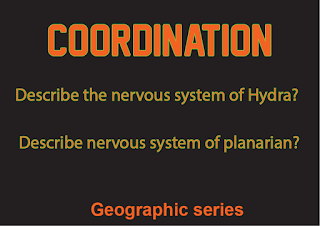Q: Describe the nervous system of Hydra?
ANS:-
NERVOUS SYSTEM OF HYDRA
The coelenterates such as Hydra are the animals
which exhibit the first well-defined nervous system. It consists simply of a network
of impulse somewhat similar nerve cells ramifying through most of the organism.
The nerve cells are inter-connected by means of synapses which are microscopic gaps
between end of neurons. There is no central control in this animal there is no
accumulation of neurons in the form of ganglia or ‘brain’. Nerve impulse
conduction is slow and can occur in either direction. The response is almost
localized. However some neurons may be differentiated either as receptors,
transmitters as effectors.

Hydra showing the nerve net, a nerve cell in the ectoderm
Hydra has no specialized muscle cells but most of
the inner and outer cell layers of the animal can contract. The response is
greatest near to the point of stimulation and gets progressively less in the
more distant regions. If Hydra is stimulated violently, it has the power of
contracting very suddenly. But Hydra performs only limited movements. Tentacles
are more contractile than the rest of the body but it can bend and shorten its
body.
Q: Describe
nervous system of planarian?
Ans:-NERVOUS SYSTEM OF PLANARIAN
The nervous system of planarian is very different
from that of Hydra. The
nervous tissue is especially concentrated into a bilobed mass called cerebral
ganglia or ‘brain’ in the anterior region of the body. From brain a
pair of longitudinal tracts or nerves called nerve cords extend all
along the entire length of the body. The nerve cells of these nerve cords serve
as link between stimulus and response. The ganglia or brain act as a
co-ordinating center for the various nerve impulses. The anterior region is
also provided with sense organs in the form of eyes and chemo-receptors.
Flatworm
show more varied behaviour and more rapid responses. If the cerebral ganglia
are removed locomotion, feeding and breeding is upset but the action of the
cilia of the body is not disturbed which seem to be controlled by the superficial
nerve net. The receptor cells are sensitive to light, pressure, touch and
chemical stimuli.




![Kind-hearted cat [] Squirrel stories](https://blogger.googleusercontent.com/img/b/R29vZ2xl/AVvXsEiYtj5tnC7ZCBPBhB2wGxuGe9eRM915NtHdTiIglqM3A22O2EESkYMcGsXZpoSRdJ1DYeo3YSP9WmIKdq_XbXAI-Vp4QXycaHWhVIf3ltzmwtWtfFJEnwA7Oo0B_7TDnAnZuDuJEWz5Hrhk/w100/cat.png)

![How to new android update; [] Latest Version of Android](https://blogger.googleusercontent.com/img/a/AVvXsEiXrh_H1xc9pMCKPk7uCg3IcgEM-TvXSf_ijOtsicwbJBFUDiuJAR1qUS2IoEWHWZyYbR-EVrZK-fvVYMBPpV_7ObD5bVwK9dRkIFE3o9NpxESdGfPfGF6UOaxPV37AythWUkSspSV8jTwGTKaiZM-YHzcETXut9fEJr6PVqi8LvBxa8a3--KQVuL5OiA=w640)